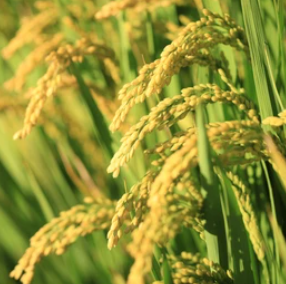Information report for ASR5;OsAsr1
Gene Details
|

|
Functional Descriptions
- Low-temperature stress increased mRNA levels of OsAsr1 in both vegetative and reproductive organs.
- Recently, we focused on ASR (Abscisic acid, Stress and Ripening) gene expression analyses and observed increased ASR5 transcript levels in roots and shoots in response to Al.
- In situ analysis showed that OsAsr1 transcript was preferentially accumulated in the leaf mesophyll tissues and parenchyma cells of the palea and lemma.
- Since this protein is regulated not only by abscisic acid but also by GA(3), these results indicate that ASR5 might be involved in plant growth in addition to stress in the basal regions of leaf sheaths.
- Because it is well known that Al induces photosynthetic dysfunction, here we discuss the hypothesis that ASR5 might be sequestered in the chloroplasts as an inactive transcription factor that could be released to the nucleus in response to Al to regulate genes related to photosynthesis.
- A proteomic approach showed that ASR5 silencing affected several proteins related to photosynthesis in RNAi rice shoots.
- The rice ASR5 protein: a putative role in the response to aluminum photosynthesis disturbance.
- Taken together, we suggest that OsAsr1 gene play an important role during temperature stress, and that this gene can be used for generating plants with enhanced cold tolerance.
- The expression of both OsAsr1 and OsASR3 was induced by drought stress, which is a major regulator of the expression of all ASR genes in rice.
- Our data also showed that the overexpression of either OsAsr1 or OsASR3 in transgenic rice plants increased their tolerance to drought and cold stress.
- ASR5 out of these six proteins was significantly regulated by GA(3) at the protein level but not at the mRNA level in the basal region of leaf sheaths.
- Identification and characterization of a gibberellin-regulated protein, which is ASR5, in the basal region of rice leaf sheaths.
- We suggest that the ASR5 protein acts as a transcription factor to regulate the expression of different genes that collectively protect rice cells from Al-induced stress responses.
- Ectopic expression of a cold-responsive OsAsr1 cDNA gives enhanced cold tolerance in transgenic rice plants.
- OsAsr1 and OsASR3 are the most abundant and are found in most tissues; they are enriched in the leaves and roots, respectively.
- , OsAsr1 in leaves and OsASR3 in roots).
- Coexpression analysis of OsAsr1 and OsASR3 and a comparison of the cis-acting elements upstream of OsAsr1 and OsASR3 suggested that their expression is regulated in common by abiotic stresses but differently regulated by hormone and sugar signals.
- Furthermore, an ASR5-GFP fusion in rice protoplasts revealed for the first time a chloroplast localization of this protein.
- This work describes the transcriptomic analysis by deep sequencing two libraries, comparing miRNA abundance from the roots of transgenic ASR5 knockdown rice seedlings with that of the roots of wild-type non-transformed rice seedlings.
- Overexpression of OsASR2 enhanced the resistance against Xanthomonas oryzae pv.
- These results suggest that the interaction between OsASR2 and GT-1 plays an important role in the crosstalk of the response of rice to biotic and abiotic stresses.
- Additionally, the expression of OsASR2 was elevated by pathogens and osmotic stress challenges.
Functional Keywords
- vegetative , root , palea , growth , transcription-factor , photosynthesis , temperature , reproductive , shoot , aluminum , drought , sheath , gibberellin , cold-stress , cold-tolerance , lemma , abiotic-stress , leaf , chloroplast , seedlings , resistance , stress , biotic-stress
Literature and News
- Structure, allelic diversity and selection of Asr genes, candidate for drought tolerance, in Oryza sativa L. and wild relatives . DOI: 10.1007/s00122-010-1348-z ; PMID: 20454772
- Identification and characterization of a gibberellin-regulated protein, which is ASR5, in the basal region of rice leaf sheaths . DOI: 10.1007/s00438-007-0317-y ; PMID: 18210155
- Ectopic expression of a cold-responsive OsAsr1 cDNA gives enhanced cold tolerance in transgenic rice plants . DOI: 10.1007/s10059-009-0055-6 ; PMID: 19390826
- Involvement of ASR genes in aluminium tolerance mechanisms in rice . DOI: 10.1111/j.1365-3040.2012.02553.x ; PMID: 22676236
- The rice ASR5 protein: a putative role in the response to aluminum photosynthesis disturbance . DOI: 10.4161/psb.21662 ; PMID: 22902685
- Abiotic stress responsive rice ASR1 and ASR3 exhibit different tissue-dependent sugar and hormone-sensitivities . DOI: 10.1007/s10059-013-0036-7 ; PMID: 23620302
- Rice ASR1 protein with reactive oxygen species scavenging and chaperone-like activities enhances acquired tolerance to abiotic stresses in Saccharomyces cerevisiae . DOI: 10.1007/s10059-012-2253-x ; PMID: 22382682
- ASR5 is involved in the regulation of miRNA expression in rice . DOI: 10.1007/s00299-015-1836-3 ; PMID: 26183952
- OsbHLH057 targets the AATCA cis-element to regulate disease resistance and drought tolerance in rice . DOI: 10.1007/s00299-022-02859-w ; PMID: 35278106
Gene Resources
- UniProt: Q53JF7
- EMBL: AC120527, AC147812, AK064892
- AlphaFoldDB: Q53JF7
- EnsemblPlants: Os11t0167800-01
- Gramene: Os11t0167800-01
- KEGG: dosa:Os11g0167800, osa:4349876
- Orthologous matrix: FHHKDKA
- InterPro: IPR003496
- PANTHER: PTHR33801, PTHR33801:SF24
- eggNOG: ENOG502S1T2
Sequences
cDNA Sequence
- >LOC_Os11g06720.1
ATAAGCAAGCAAGCAAAGCCACATCTTATTGTCACTTCCATCTCATTCTCCTAATTGTCATCACTAGCTTCTAGCTAGCTTAATTAATTAATTAGCCATGGCGGAGGAGAAGCACCACCACCACCTGTTCCACCACAAGAAGGACGACGAGCCGGCCACCGGAGTAGACTCCTACGGCGAGGGCGTCTACACGTCGGAGACGGTGACCACCGAGGTGGTCGCCGGCGGCCAGGACGAGTACGAGAGGTACAAGAAGGAGGAGAAGCAGCACAAGCACAAGCAGCACCTCGGCGAGGCCGGCGCCCTCGCCGCCGGCGCCTTCGCCCTGTATGAGAAGCACGAGGCGAAGAAGGACCCGGAGAACGCGCACAGGCACAAGATCACGGAGGAGATCGCGGCCACGGCGGCGGTCGGCGCCGGCGGCTACGCCTTCCACGAGCACCACGAGAAGAAGAAGGACCACAAGAGCGCCGAGGAGTCCACCGGCGAGAAGAAGCACCACCTCTTCGGCTGATCGACCTCATCACAACGTCGCCGGCGGCGGCGACGACCTCGCCGTACGTCGCCGGCCGCCGTGTCGTCGATTTGTGTGTGTAATAATTTGTCTTCTTCTGCATGCGTGGTGTTGCTGTTTTTCACAAGAGTCTCCGGCCTCGACCAGTGAGAGGCTGACAGGTGGGGCCGTGAGTTCAGCTTGTGTTGCTTGATTTTCTCTGCAGCCTTGCCCTCTGTGTGTCCAAATAAGTGGTGTGCATGGCTCTCTCCGTGTCATGTATCAATGTATTTTTATCTGTACTTTGTACAAGTGAAGCAATATTTATCGAACCTTGACTTTCTCCATTCTATTTGAAAAACCATTAAAGTTGAGTAGA
CDS Sequence
- >LOC_Os11g06720.1
ATGGCGGAGGAGAAGCACCACCACCACCTGTTCCACCACAAGAAGGACGACGAGCCGGCCACCGGAGTAGACTCCTACGGCGAGGGCGTCTACACGTCGGAGACGGTGACCACCGAGGTGGTCGCCGGCGGCCAGGACGAGTACGAGAGGTACAAGAAGGAGGAGAAGCAGCACAAGCACAAGCAGCACCTCGGCGAGGCCGGCGCCCTCGCCGCCGGCGCCTTCGCCCTGTATGAGAAGCACGAGGCGAAGAAGGACCCGGAGAACGCGCACAGGCACAAGATCACGGAGGAGATCGCGGCCACGGCGGCGGTCGGCGCCGGCGGCTACGCCTTCCACGAGCACCACGAGAAGAAGAAGGACCACAAGAGCGCCGAGGAGTCCACCGGCGAGAAGAAGCACCACCTCTTCGGCTGA
Protein Sequence
- >LOC_Os11g06720.1
MAEEKHHHHLFHHKKDDEPATGVDSYGEGVYTSETVTTEVVAGGQDEYERYKKEEKQHKHKQHLGEAGALAAGAFALYEKHEAKKDPENAHRHKITEEIAATAAVGAGGYAFHEHHEKKKDHKSAEESTGEKKHHLFG*